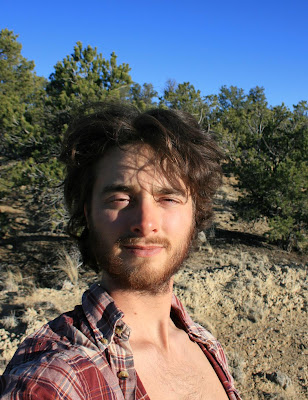The grocery store girls think its glamorous to plant trees and save the planet. But Why? How?
Poetic Interlude: Chainsaw Frenzy
--
yellin
yeah! alright! yeah!
carry the dead and dying
on our shoulders
rough, quick surgery
on our knees
load em quick onto the truck
--
During the winter, when the trees are hibernating, we cut branches and stems and soak the poles for two weeks to two months. We lop off most of the branches so the tree puts less energy into leafing out and more energy into its roots. Then we take them to a faraway river, a river where no trees grow. We build roads and drill holes and plant the poles and hope they grow into trees. The native plants grow and provide habitat for animals and other plants. They provide organic debris and obstructions that can secure banks while inducing meanders (through, e.g. beaver dams or natural log jams). Healthy natives outcompete invasive alien species.
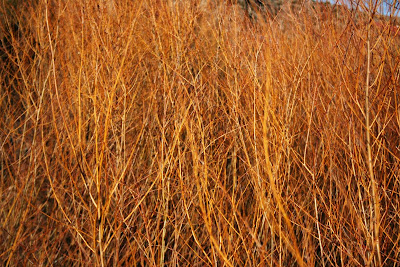
So that's who we are: we plant trees. Silviculturalists. Farmers with an aesthetic flair. Landscape architects. (link) But why? Why toil in the mud and in the dust. In the middle of nowhere, gripping trees with white knuckles over swirling swift water and gasping quicksand. Why all the blood, sweat, and cussing?
One could enumerate the various rationales for tree planting and still end with the existential answer: that's just who we are. Basically, our specialty is planting native trees (like willow and cottonwood) along rivers where they used to grow, but were cut down and people let too many cows eat all the young ones so that it has come to the point where mother nature cannot regenerating autonomously (Ecosystem Collapse). Someone has to step in and plant the next generation...nature is broken and can't fix itself.
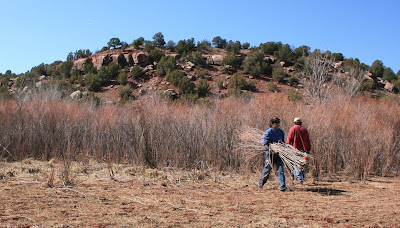
But we aren't restoring nature to full health. We're just planting trees, and its important to note that in a sense we are not restoring a functioning healthy ecosystem. Our restored ecosystem is NOT sustainable without humans, We're the immune cells of the ecosystem, dispatched to patch up the holes in the fabric of the circle of life. What holes? The absence of wolves, for one. We have to build tall fences, not just to keep out the nonnative cows from overgrazing and breaking our fledgling forest, but also to stop elk from practicing their mating performance on our tender cottonwood poles. Without wolves to scare elk, and without an entire forest of cottonwood to satiate them, even the native organisms in the ecosystem could have deleterious effects to our restoration effort.
This idea isn't without controversy. While some argue that the effect of large predators, the footprint on the ecosystem, is disproportionate to their number or size, others argue that the key problem in our ecosystem is lack of mycorrhizal fungi. The argument is essentially the same as the top-down vs bottom-up argument in neuroscience. Do charismatic megafauna have a top-down regulatory effect that controls a number of keystone processes or is it the primary productivity of the grasses, or even the health of the lichen, that is the determining factor? cite "Ecosystems Unraveling" William Stolzenburg in Conservation Magazine January-March 2008 (Vol. 9, No. 1)
But is it any coincidence that the charismatic megafaunal species we gravitate toward would hold the reins of power? What dark power the jaguar still holds over us, even snug in our surround-sound living rooms...as our eyes are drawn toward beauty, aren't they also to the power of the magestic eagle and the cunning coyote. In fact, across our America, aren't the mascots of every high school and college sports' team a large carnivore? (Would we think mammals cute if they behaved like insects, sucking blood and infesting our bodies and crops?)
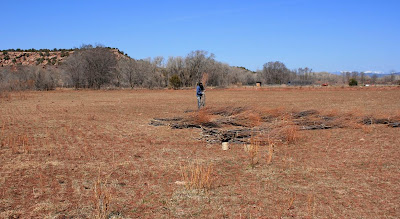
Our work is ironic because we are doing work either wouldn't have to be done or that would be done for free, if we followed the ecological realities of the region and left the ecosystem alone to do its job. But in a situation where the best thing you can do is not touch something....humans have a hard time with that. And, because we're men and like to drive heavy machinery cross-country in a continuing ironic representation of our understanding of and unity with nature. We can help it heal a little faster, and possibly a lot faster. The logical endpoint of our desire would be to open a bottle and presto! instant forest.
The ecosystem has passed a threshold where it is no longer resilient to its original state. At best, you could argue that the grazed rangeland state is neutrally stable, that is, stable at the new point it finds itself at. But, judging from the unsustainable rate of erosion, this is unlikely. (cite Ecology text)
Dynamic equilibrium can mean the ecosystem is unbalanced and moves far from natural healthy processes..into a new steady state, or into a spiral of positive feedback? will a stream naturally correct its meander, or keep downcutting, the headcuts getting worse and worse....? To answer these question, due consideration of time scales are important. For our impatient human time scales, active restoration may be called for, even if the ecosystem is dynamically stable, but will take too long to return to equilibrium.
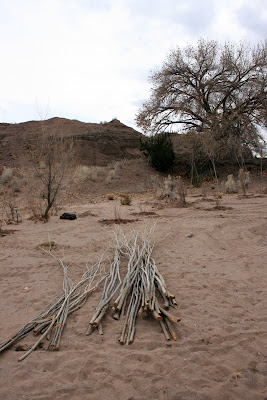
Some argue that trees use water. For example, while the city of Las Vegas has plans to clear out all the tamarix upstream of its Colorado river water intake, they do not have plans to complete our second half of restoration, namely planting native trees. That would negate the entire single-minded purpose of the city of Las Vegas.
Some argue we are not actually increasing the total number of trees through all our hardwork cutting, transporting, and replanting them. We are not increasing the total number of trees, but, of course, as ecologists are fond of noting, plants and trees in particular are not singular but modular, so that one tree can grow, in the right conditions, into a much larger tree.
We expend a large amount of carbon in the form of nondomestic, unsustainable petroleum products. We consume and produce waste. We buy timber products that are cut from the national forests, and eat food that is produced on rangeland and farmland. We are part of the system, but we are also part of the solution, and we hope that our carbon negative contribution from the trees outweighs that bad karma/carbon positive contribution from our lifestyle. Of course, no one has done the math, nor do they want to. Guardians is not quite ready to take on that level of professional standards or adopt a lifestyle solution like battery, hydrogen, or biodiesel, (or Bedouin gypsies working out of their vans). There just isn't a good answer out there, but yeah, we're in the market. Sucks that the superheroes gotta pollute to get to the crime scene to save the planet...Everything that we consume, that cost (of providing ecosystem benefits when the ecosystem is broken), needs to be added to the value a healthy ecosystem produces.
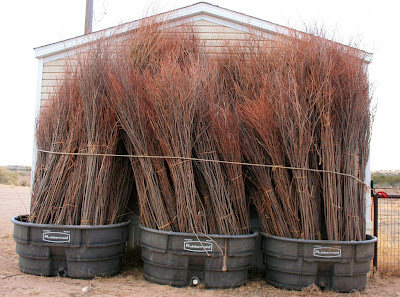
And we have already determined that, since these type of restoration projects continue to call for both active management and passive vigilance (eternal vigilance, for that matter), they are not durable, but that does not mean that they are not sustainable. Can a human tradition work to create sustainability, or must we defer to nature, for wherever human ambition goes, human folly follows. Plus, if we argue that our conservation is dependent on humans, why not follow the argument of ranchers, who claim that cows are necessary for the health of an ecosystem that didn't formerly support large grazers. In fact, Dan Dagget's book
Gardeners of Eden follows just such an argument, with numerous case example of denuded and degraded rangeland that has failed to respond (in our time scale) to human/cattle removal, but then remarkably improved with a certain magic mixture of the man and managed cows. Unfortunately, Dagget's anecdotal remarks, while providing ample argument that sometimes in some places the damage we can do to the land is not self-correcting, he fails to prove the positive point; that humans are necessary to the health of the land. Unfortunately, because in our tree planting, we are a necessary part of the plan, without which the first baby steps of tree propagation would be hopeless. That's job security in the restoration biz. Some humans try to patch things up but the rest keep right on injurin'.
We are just a demonstration project, and necessarily so. The actual weight of restoration work that critically needs attention is too vast to tackle without a small army -- something like the CCC over again. Right now our projects serve as lighthouses, markers of what could be, and experiments in determining how far and how much we've lost. We haven't gone to a place beyond the city lights and not turned on a light, but we have tried to grow a plant in the desert, and know of the value of sweat, blood, and alternately cursing and entreating the heavens.
There are those who question the personal narrative and motivation to undertake this kind of work. Chauvinistic masochism, etc. And, indeed, there is much soul-searching and many want to quit. "Drawing upon the Buddhist tradition is the work of Joanna Macy. Macy, working as an anti-nuclear activist in USA, found that one of the major impediments confronting the activists' cause was the presence of unresolved emotions of despair, grief, sorrow, anger and rage. The denial of these emotions led to apathy and disempowerment." But, for whatever reason, we were born for this work and this drama. If you see something that needs to be done for good, you just do it, and write essays about it afterwards.

So we go in with the big yellow machines. It could be argued that these industrial behemoths also, in passing, fill some of the ecological niches left vacant and provide some of the ecological services that remain inoperative since the Pleistocene megafauna's disappearance. CF:
Laurel's Wild Ride Bringing Back the PleistoceneAnyone who's ever floundered through thickets can attest to the valuable velocity of a pithy path in the heart of such havoc. The need for giant mechanical elephants to tear through the underbrush is appreciated most by those hardy souls who dare flounder through the thickets of sagebrush, impenetrable by even elk and cows... Do the elk feel the loss of their larger herbivore cousins in the foreboding overgrown places of today's altered landscapes?
Finally, on the last day of the planting season, a volunteer asked me what my role was. Poet, witness, scientists, journalist, storyteller, property manager, mascot...at a loss for words I could only say that "I plant trees". And the simple fact was enough of a reason. I think people understand that.


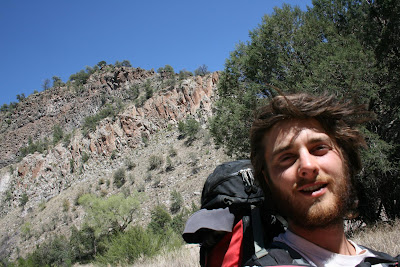

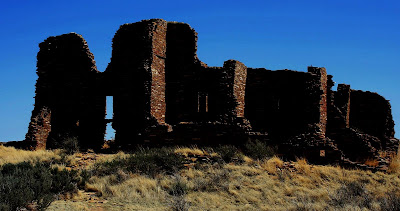
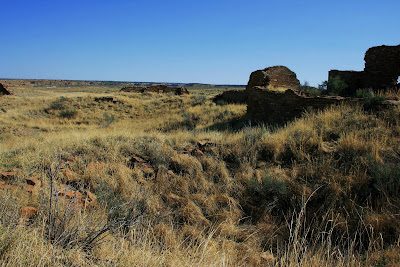
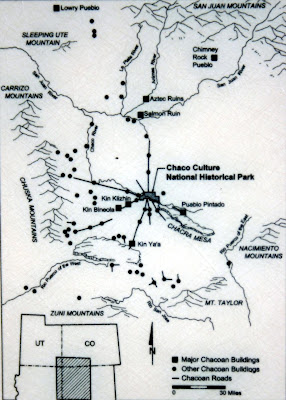
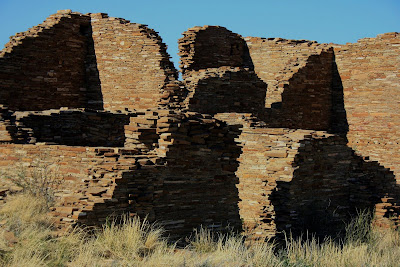
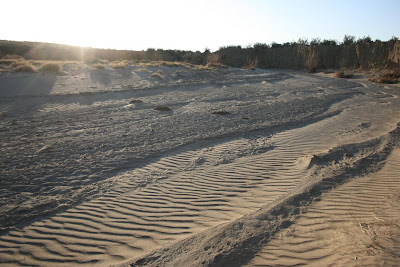
 strange dreams, think not on
strange dreams, think not on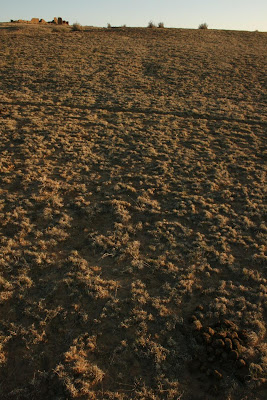









 Some argue that trees use water. For example, while the city of Las Vegas has plans to clear out all the tamarix upstream of its Colorado river water intake, they do not have plans to complete our second half of restoration, namely planting native trees. That would negate the entire single-minded purpose of the city of Las Vegas.
Some argue that trees use water. For example, while the city of Las Vegas has plans to clear out all the tamarix upstream of its Colorado river water intake, they do not have plans to complete our second half of restoration, namely planting native trees. That would negate the entire single-minded purpose of the city of Las Vegas.

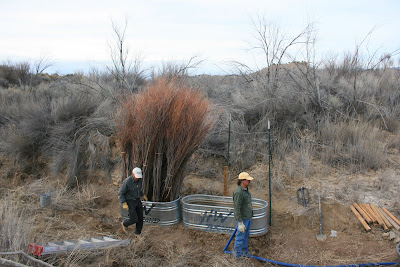 After all the city folk and designer ranchers on polysyllabic horse breeds had left, the river was silent.
After all the city folk and designer ranchers on polysyllabic horse breeds had left, the river was silent.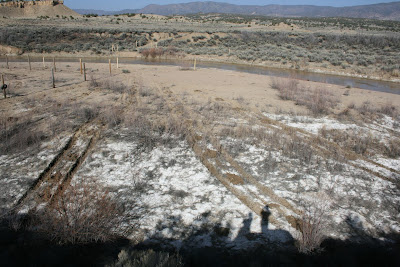 A wind died and the sun shone along the edge of the sky girdling cloud and lit the world anew.
A wind died and the sun shone along the edge of the sky girdling cloud and lit the world anew.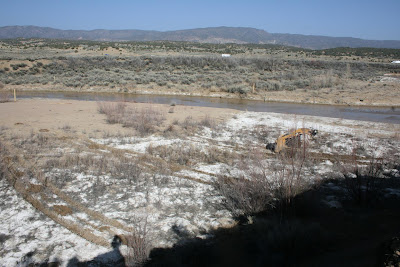 The meadow lark, who had scolded our transgressions against its favorite olive tree, was quiet.
The meadow lark, who had scolded our transgressions against its favorite olive tree, was quiet. Creation happens every day and those who camp out know the important events of the day are measured in the stillness of the quotidian sunrise and sunset.
Creation happens every day and those who camp out know the important events of the day are measured in the stillness of the quotidian sunrise and sunset.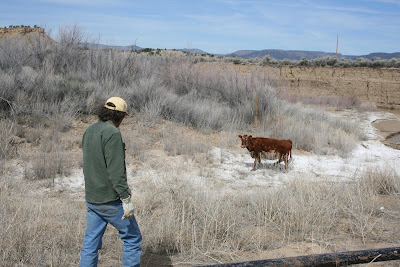 (Cow I)
(Cow I)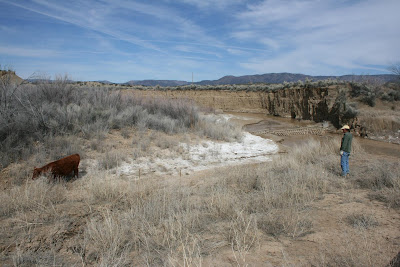 (Cow II)
(Cow II)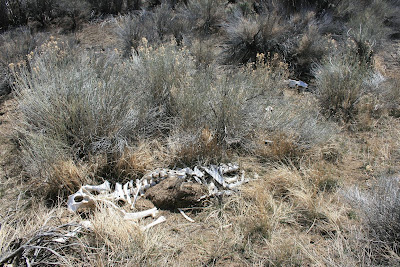 (Cow III)
(Cow III)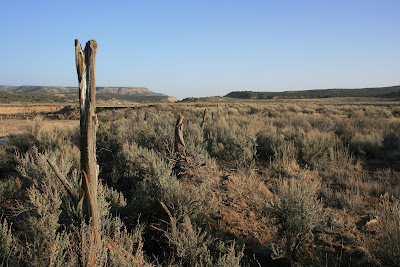 ...as infinite passion and grandeur bathed my face in God's (why not say it?) loving beatitude, I understood the beauty in the complexity written on his face in tattered streamers of cloud, now dimpled, here undulating, lurid yet calm and innocent.
...as infinite passion and grandeur bathed my face in God's (why not say it?) loving beatitude, I understood the beauty in the complexity written on his face in tattered streamers of cloud, now dimpled, here undulating, lurid yet calm and innocent.
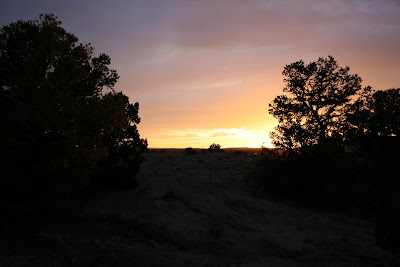 I was just in my backyard, enjoying the magnificense of 10,000 acres and no people.
I was just in my backyard, enjoying the magnificense of 10,000 acres and no people. Not listening tothe pope in a crowded room, or watching other men's lips move in the idiot box or in the shadows above a beer can. How do I come by this good fortune?
Not listening tothe pope in a crowded room, or watching other men's lips move in the idiot box or in the shadows above a beer can. How do I come by this good fortune?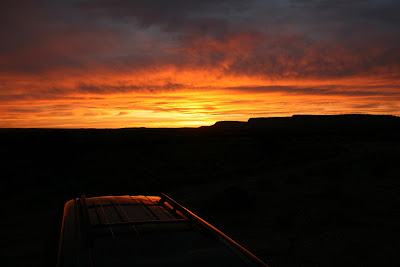 My trusty steed, Betelgeuse.
My trusty steed, Betelgeuse. My trash for the week, and mi sombrero.
My trash for the week, and mi sombrero.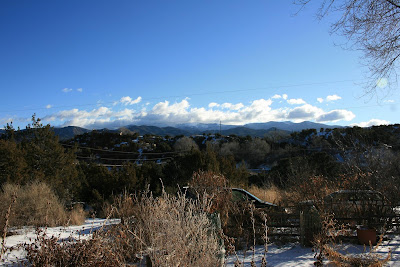 The scenery, the shocks. Sometimes I wonder what it means to own something, like this van that was given to me, from my parents and society and the earth, and will return to them, or my jacket, that I found and that could be taken or lost or destroyed at any time. Or this cool spot where the yellow flowers bloom in the abandoned ceremonial pits while the sky stretches over an immense landscape laid open bellow me to the horizon in every direction. Or the entire system of public lands that is our birthright and our trust.
The scenery, the shocks. Sometimes I wonder what it means to own something, like this van that was given to me, from my parents and society and the earth, and will return to them, or my jacket, that I found and that could be taken or lost or destroyed at any time. Or this cool spot where the yellow flowers bloom in the abandoned ceremonial pits while the sky stretches over an immense landscape laid open bellow me to the horizon in every direction. Or the entire system of public lands that is our birthright and our trust.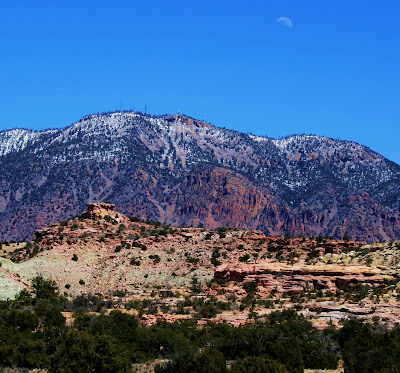 The Southwest is so beautiful...I had to start exploring it.
The Southwest is so beautiful...I had to start exploring it. I am a Forest Guardian, I speak for the trees. I am the embodiment of a Lifestyle Organization. Older people give younger people the money they need in order to live the lifestyle "to which they would like to become accustomed". These older people buy, with their tax deductible contribution, an entire world more to their taste and liking. They are not buying a place in heaven. It is a firmly grounded and embodied reality. A place on earth, or rather a whole landscape of places: acreages and access. They buy better Quality of Life (QoL) The product delivered is both short term, specific, and long term, diffuse. It is the way health care should be: both preventative and curative. A positive vision of health. So the more the lifestyle of the younger confirms the choices of the older, the more successful the business. Isn't that how all business operates?
I am a Forest Guardian, I speak for the trees. I am the embodiment of a Lifestyle Organization. Older people give younger people the money they need in order to live the lifestyle "to which they would like to become accustomed". These older people buy, with their tax deductible contribution, an entire world more to their taste and liking. They are not buying a place in heaven. It is a firmly grounded and embodied reality. A place on earth, or rather a whole landscape of places: acreages and access. They buy better Quality of Life (QoL) The product delivered is both short term, specific, and long term, diffuse. It is the way health care should be: both preventative and curative. A positive vision of health. So the more the lifestyle of the younger confirms the choices of the older, the more successful the business. Isn't that how all business operates? Migratory and Bedouin
Migratory and Bedouin Following the changing seasons, subsisting off the land. Local wine and buffalo. Thoreau said simplify, simplify, so I don't bother heating my food: saves on energy and cleaning dishes. Every day there is a new view out the window. Can you feel the language slipping away? There is no written culture on the Prairie.
Following the changing seasons, subsisting off the land. Local wine and buffalo. Thoreau said simplify, simplify, so I don't bother heating my food: saves on energy and cleaning dishes. Every day there is a new view out the window. Can you feel the language slipping away? There is no written culture on the Prairie.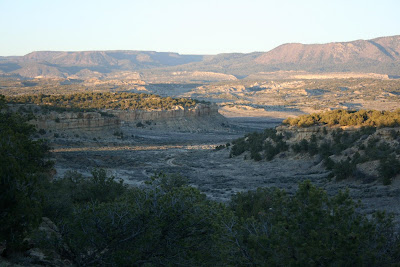 Constant movement, movement as a morality.
Constant movement, movement as a morality.